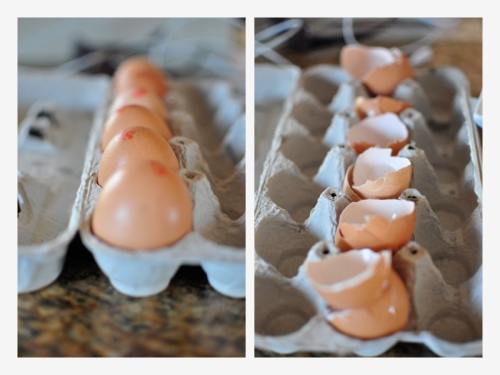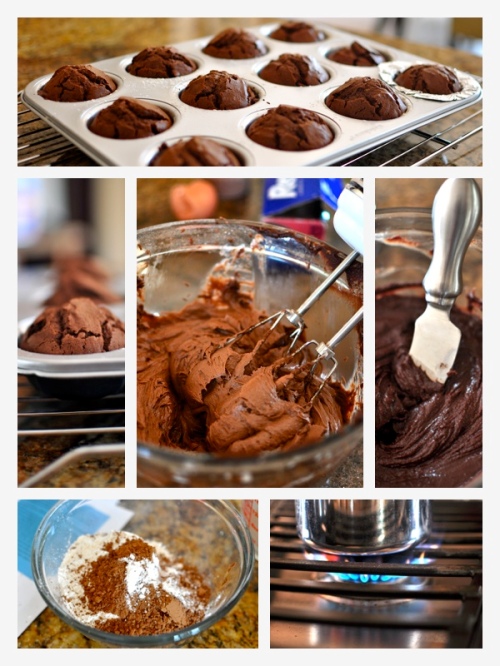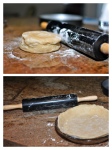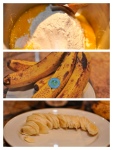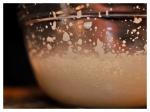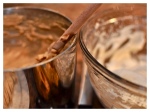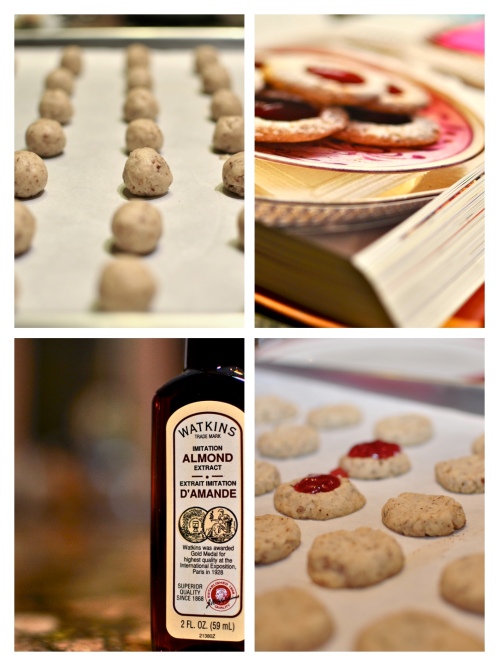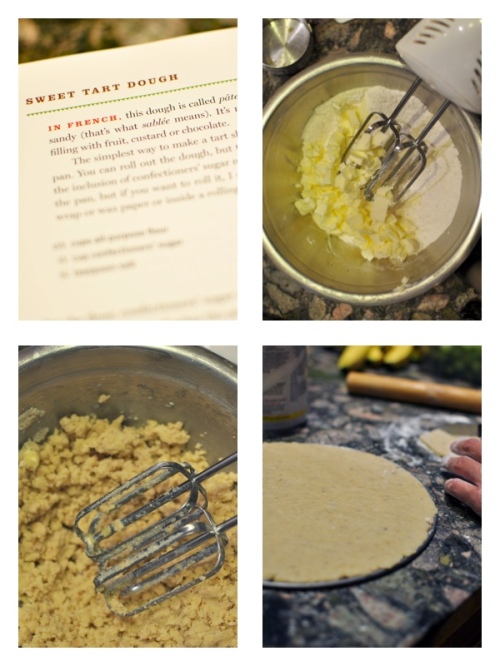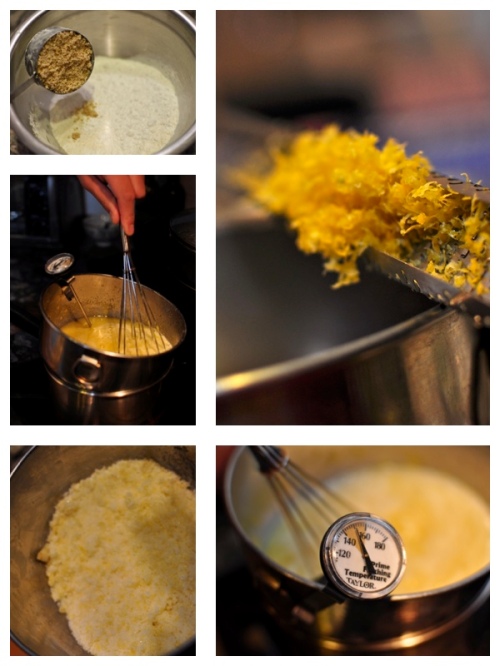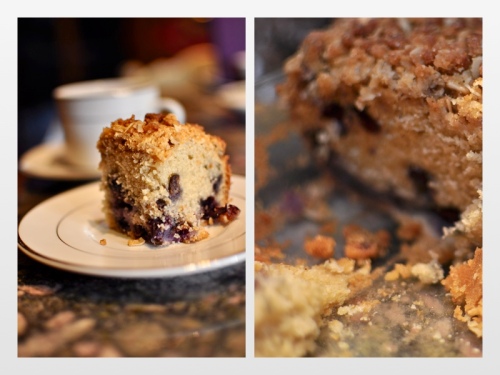Brioche au Chocolat
by reenrene
[Tim] Holy bread! Give us this day our daily brioche and forgive us our sweet teeth, as we forgive those who diet against us. Like manna, this brioche was dumped. That’s the Oven Number 2 Process (ON2P): Prep em, bake em, dump um, eat em. Pardon my language but the pun is intentional – that’s good shit. 
 Double stuffed tangy nuggets in-between those cheeks. Pastry cream is cream for pastries. If all words followed that logic, a chocolate bar would be a bar for chocolate, and a cook book would be a book for cooking. Which it is.
Double stuffed tangy nuggets in-between those cheeks. Pastry cream is cream for pastries. If all words followed that logic, a chocolate bar would be a bar for chocolate, and a cook book would be a book for cooking. Which it is.
Sometimes you can let pictures speak for themselves, but I want is a picture to taste for itself, hear, smell, walk, and unicycle for itself . A fully sensual unicycling picture – that’d be my second wish if I had a magic genie bottle. The first would be for super powers (not needing to sleep), and I’d save my third for emergency circumstances.

Making brioche is fun… the filling made it fabulous. Why is that word affiliated with gays? And why is the word gay associated with homosexuals? This gay bread made me gay – hopefully it’ll make you gay too.
Here’s the recipe, shamelessly copied from this blog. They did it too, and the adage holds true: “There’s always someone on the internet better than you.”
Brioche au Chocolat
from Flour: Spectacular Recipes from Boston’s Flour Bakery + Cafe
makes 10 pastries
1/2 recipe Basic Brioche dough (recipe follows)
1 recipe Pastry Cream (recipe follows)
4 oz (114g) bittersweet chocolate (62 to 70 percent cacao), chopped, or bittersweet chocolate chips (just under 2/3 cup). POC Note: This pastry is not supersweet- the bittersweet chocolate adds a hint of sweetness with a bitter kick. If you are truly opposed to all bittersweetness and insist that your pastries must be perfectly sweet (Hey, to each his own)- use a good quality semisweet chocolate in its place.
1 egg
Line a baking sheet with parchment paper.
On a floured work surface, roll out the dough into a rectangle about 20 inches by 10 inches and 1/4 inch thick. It will have the consistency of cold, damp Play-Doh and should be fairly easy to roll. Position the rectangle so a long side is facing you. Spread the pastry cream evenly over the bottom half (a 20 by 5 inch section) of the rectangle. Fold the top half of the rectangle completely over the bottom half, then press down gently so the halves are smooshed together.
Use a bench scraper of a chef’s knife to cut the filled dough into 10 pieces, each about 2 inches wide; each piece will be about 2 by 5 inches. (At this point, the unbaked pastries can be tightly wrapped in plastic and frozen for up to 1 week. When ready to bake, thaw them, still wrapped, in the refrigerator overnight or at room temperature for 2 to 3 hours, then proceed as directed.)
Carefully transfer the brioche to the prepared baking sheet. Cover the pastries lightly with plastic wrap and place in a warm spot to proof for about 2 hours, or until the dough is puffy, pillowy, and soft. Position a rack in the center of the oven, and heat the oven to 350 degrees F.
In a small bowl, whisk the egg until blended. Gently brush the tops of the pastries with the beaten egg.
Bake for 35 to 45 minutes, or until golden brown. Let cool on the baking sheet on a wire rack for 20 to 30 minutes. The pastries tend to bake into one another in the oven, so break apart into 10 pieces. The pastries are best served warm or within 4 hours of baking. They can be stored in an airtight container at room temperature for up to 1 day, and then warmed in a 300-degree-F oven for 5 minutes before serving.
Basic Brioche
from Flour: Spectacular Recipes from Boston’s Flour Bakery + Cafe
*Makes 2 loaves
Note: Do not halve this recipe. There won’t be enough dough to engage the dough hook of your mixer, and the dough won’t get the workout it needs to become a light, fluffy bread. Don’t worry about having too much: Both the dough and the baked loaves freeze well, and having a freezer filled with brioche is never a bad thing.
2 1/4 cups (315 grams) unbleached all-purpose flour
2 1/4 cups (340 grams) bread flour
1 1/2 packages (3 1/4 teaspoons) active dry yeast, or 1 ounce (28 grams) fresh cake yeast
1/2 cup plus 1 tablespoon (82 grams) sugar
1 tablespoon kosher salt
1/2 cup (120 grams) cold water
6 eggs
1 cup plus 6 tablespoons (2 3/4 sticks/310 grams) unsalted butter, at room temperature, cut into 10 to 12 pieces
In a stand mixer fitted with the dough hook, combine the all-purpose flour, bread flour, yeast, sugar, salt, water, and 5 of the eggs. Beat on low speed for 3 to 4 minutes, or until all of the ingredients have come together. Stop the mixer as needed to scrape the sides and bottom of the bowl to make sure all of the flour is incorporated into the wet ingredients. Once the dough has come together, beat on low speed for another 3 to 4 minutes. The dough will be very stiff and seem quite dry.
On low speed, add the butter one piece at a time, mixing after each addition until it disappears into the dough. Then, continue mixing on low speed for about 10 minutes, stopping the mixer occasionally to scrape the sides and bottom of the bowl. It is important for all of the butter to be mixed thoroughly into the dough. If necessary, stop the mixer occasionally and break up the dough with your hands to help mix in the butter.
Once the butter is completely incorporated, turn up the speed to medium and beat for another 15 minutes, or until the dough becomes sticky, soft, and somewhat shiny. It will take some time to come together. It will look shaggy and questionable at the start and then eventually will turn smooth and silky. Then, turn the speed to medium-high and beat for about 1 minute. You should hear the dough make a slap-slap-slap sound as it hits the sides of the bowl. Test the dough by pulling at it: it should stretch a bit and have a little give. If it seems wet and loose and more like a batter than a dough, add a few tablespoons of flour and mix until it comes together. If it breaks off into pieces when you pull at it, continue to mix on medium speed for another 2 to 3 minutes, or until it develops more strength and stretches when you grab it. It is ready when you can gather it all together and pick it up in one piece.
Place the dough in a large bowl or plastic container and cover it with plastic wrap, pressing the wrap directly onto the surface of the dough. Let the dough proof in the refrigerator for at least 6 hours or up to overnight. At this point, you can freeze the dough in an airtight container for up to 1 week.
To make two brioche loaves, line the bottom and sides of two 9 by 5 inch loaf pans with parchment, or butter the pans liberally. Divide the dough in half and press each piece into about a 9-inch square. The dough will feel like cold, clammy Play-Doh. Facing the square, fold down the top one-third toward yo, and then fold up the bottom one-third, as if folding a letter. Press to join these layers. Turn the folded dough over and place it, seam-side down in one of the prepared pans. Repeat with the second piece of dough, placing it in the second prepared pan.
Cover the loaves lightly with plastic wrap and place in a warm spot to proof for about 4 to 5 hours, or until the loaves have nearly doubled in size. They should have risen to the rim of the pan and be rounded on top. When you poke at the dough, it should feel soft, pillowy and light, as if it’s filled with air – because it is! At this point, the texture of the loaves always reminds me a bit of touching a water balloon.
Position a rack in the center of the oven, and heat the oven to 350 degrees F.
In a small bowl, whisk the remaining egg until blended. Gently brush the tops of the loaves with the beaten egg.
Bake for 35 to 45 minutes, or until the tops and sides of the loaves are completely golden brown. Let cool in the pans on wire racks for 30 minutes, then turn the loaves out of the pans and continue to cool on the racks.
The bread can be stored tightly wrapped in plastic wrap at room temperature for up to 3 days (if it is older than 3 days, try toasting int) or in the freezer for up to 1 month.
Pastry Cream
from Flour: Spectacular Recipes from Boston’s Flour Bakery + Cafe
1 1/4 cups (300g) milk
1/2 cup (100g) sugar
1/4 cup (30g) cake flour
1/2 tsp kosher salt
4 egg yolks
1 tsp vanilla extract
In a medium saucepan, scald the milk over medium-high heat (bubbles start to form around the edges of the pan, but the milk is not boiling). While the milk is heating, in a small bowl, stir together the sugar, flour, and salt. (Mixing the flour with the sugar will prevent the flour from clumping when you add it to the egg yolks.) In a medium bowl, whisk the egg yolks until blended, then slowly whisk in the flour mixture. The mixture will be thick and pasty.
Remove the milk from the heat and slowly add it to the egg-flour mixture, a little at a time, whisking constantly. When all of the milk has been incorporated, return the contents of the bowl to the saucepan and place over medium heat. Whisk continuously and vigorously for about 3 minutes, or until the mixture thickens and comes to a boil. At first, the mixture will be very frothy and liquid; as it cooks longer, it will slowly start to thicken until the frothy bubbles disappear and it becomes more viscous. Once it thickens, stop whisking every few seconds to see if the mixture has come to a boil. If it has not, keep whisking vigorously. As soon as you see it bubbling, immediately go back to whisking for just 10 seconds, and then remove the pan from the heat. Boiling the mixture will thicken it and cook out the flour taste, but if you let it boil for longer than 10 seconds, the mixture can become grainy.
Pour the mixture through a fine-mesh sieve into a small heat-proof bowl. Stir in the vanilla, then cover with plastic wrap, placing it directly on the surface of the cream. This will prevent a skin from forming. Refrigerate for at least 4 hours, or until cold, or up to 3 days.












